|
Thurs., June 14
10:30 a.m.
Research Techniques Seminar - WH-10NW, West Wing
Speaker: J. Hamilton, University of Wisconsin, Platteville
Title: Diamonds in Washington and Volcanic Dust in Hawaii:
Optical Surface Studies Using First Contact Polymers
1:00 p.m.
ILC ALCPG Physics and Detector R&D Seminar - WH-8XO, Hornets' Nest
Speaker: C. Milstene, Fermilab
Title: Precision Measurement of the Stop Mass at the ILC
2:30 p.m.
Theoretical Physics Seminar - Theory Conf Rm, WH-3NW (NOTE LOCATION)
Speaker: N. Christensen, Michigan State University
Title: Unitarity and Bounds on the Scale of Fermion Mass Generation
3:30 p.m.
DIRECTOR'S COFFEE BREAK - 2nd Flr X-Over
4:00 p.m.
Accelerator Physics and Technology Seminar - One West
Speaker: J. Kerby, Fermilab
Title: Status of the LHC Inner Triplets
Fri., June 15
1:00 p.m.
Special Joint Experimental-Theoretical Physics Seminar - One West
Speaker: E. de la Cruz Burelo, University of Michigan, Ann Arbor
Title: Observation of a New b-baryon Ξb at DZero:
Celebrating 30 Years of Beauty at Fermilab
3:30 p.m.
DIRECTOR'S COFFEE BREAK - 2nd Flr X-Over
4:00 p.m.
Joint Experimental-Theoretical Physics Seminar - One West
Speaker: J.-P. Kneib, Observatoire Midi-Pyrenees
Title: Mapping Dark Matter in the Universe with Gravitational Lensing
Click here for NALCAL,
a weekly calendar with links to additional information. |
Thursday, June 14
-Southwestern chicken tortilla
-Philly style cheese steak
-*Garlic herb roasted pork
-Tomato basil chicken parmesan
-Southwestern turkey wrap
-Assorted sliced pizza
-*Marinated grilled chicken caesar salad
*Carb Restricted Alternative
Wilson Hall Cafe Menu |
|
Thursday, June 14
Dinner
- Shrimp & chorizo kebobs
- Pork tenderloin w/ mexican chipotle marinade
- Sweet potatoes & poblano peppers
- Rum raisin soufflé
Wednesday, June 20
Lunch
- Arranchera al carbon
- Roasted red Peppers
- Warm tortillas
- Pico de gallo
- Black bean & corn salad
- Coconut rice pudding
Chez Leon Menu
Call x4598 to make your reservation. |
|
|
Tuition Assistance Program supports career development
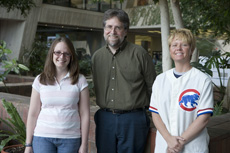
Tuition assistance program graduates: Molly Anderson, CD; Robert Bernstein, PPD; and Cynthia Arnold, BS. Not pictured: Diana Canzone, BS; Ruben Carcagno, TD; Nicholas Gurley, AD; and James Kerby, TD.
It doesn't matter whether you are more familiar with MINOS or media -- Fermilab's Tuition Assistance Program provides countless opportunities for degree completion in a variety of academic areas.
Fermilab employees may enroll in degree programs or take college accredited courses that will help better their ongoing work at the lab. The TA Program grants tuition advances to full and part-time employees and reimbursements to students in the cooperative education program. Seven individuals completed degrees funded through the program this year.
A BFA recipient in Digital Media Production, Cynthia Arnold started working at Fermilab in 1991 as an on-call cafeteria worker. A year later she was hired as a full-time employee in Visual Media Services and applied to the TA Program to obtain her bachelor's degree.
"As technology changed, so did my job responsibilities," said Arnold. "I worked here for about seven years before I pursued my degree. Fermilab paid for 100 percent of my education."
On the opposite end of the educational spectrum is Engineering Manager Ruben Carcagno, Head of the Technical Division's Test and Instrumentation Department. Carcagno began his masters of engineering management coursework at Northwestern University in the fall of 2003 and finished last August.
"I was interested in a program that emphasizes management skills specifically required in a technology-based organization such as Fermilab, and Northwestern's MEM program was a good match," said Carcagno, who currently manages the IB1 Test Facility.
Arnold continues to work in the VMS department on tasks ranging from photography to graphic design. Carcagno is currently expanding the role of his IB1 facility to include instrumentation of the ILC Superconducting RF cavities, with the first vertical test stand scheduled to start commissioning this summer.
For more information on the Tuition Assistance Program, click here.
-- Lauren Younis
|
Physicists accelerate particles, race dragons
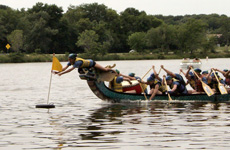
Fermilab's dragon boat racing team reaches for their flag Sunday morning during the Pride of the Fox festival in St. Charles.
Particle physicists commonly seek high velocities in their work, but some also have a "need for speed" in their free time. Last Sunday, a group of post-docs, graduate students, and scientists from across the lab met at Pottawatomie Park in St. Charles, IL, to put their acceleration skills to work in a unique way. The group, known as the Draggin' Runners, is Fermilab's own dragon-boat racing crew.
Founded by members of CDF in 2001, the Runners have participated in the "Pride of the Fox River-Fest" competition each year, skimming the waters in a forty foot-long ship that resembles a Chinese dragon. Competitions consist of two teams racing head-to-head, striving to be the first to grab a flag at the end of their lane. Crews consist of twenty members: eighteen paddlers, a flag catcher, and a drummer.
This year, the Draggin' Runners consisted mostly of rookies, retaining only five members from previous years. Barbara Alverez, a grad student on CDF who became interested as a spectator last year, said that while the activity was physically demanding, it was also "great fun."
Dragon-boat racing has existed as a religious rite in Southern China for around 2,300 years. While Fermilab scientists may not be interested in currying favor with the Heavenly Dragon, they do enjoy having a good time. JJ Schmidt of CDF initially proposed the idea to his friends as a "fun, large group activity," and the attitude of the team on Sunday reflected this cheerfully competitive spirit.
Despite lacking experience, the Fermilab team won its qualifying match, and barely lost in the finals. Following the race, Schmidt said that the team had been 'in sync,' and stated confidently, "We'll be back."
Those interested in joining the Draggin' Runners should contact Rick Tesarek for more information.
-- J. Bryan Lowder
|
Feature - A conversation with TeraGrid's Dane Skow
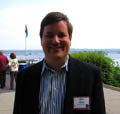 |
"There is nothing like seeing what you've done result in improvement for the nation and the world. This keeps me motivated. This wonderful synergy energizes us all." Dane Skow.
Image courtesy of Danielle Venton. |
Last week at TeraGrid '07 iSGTW sat down with director of TeraGrid's Grid Infrastructure Group, Dane Skow, to discuss the current state of TeraGrid and his hopes for its future.
iSGTW: Thank you for sitting down with us, Dane. First, can you review for our readers the current state of TeraGrid's activity?
Dane Skow: Certainly. We are now comprised of nine resource providers, spread across the United States, all funded by the National Science Foundation. We now have over 280 teraflops worth of computing capability, over 30 petabytes of data storage, and over 25 different resources that we allocate through a national peer review process.
Read More
|
From Chicago Sun-Times
June 14, 2007
'It was like finding a small needle in a large haystack'
FERMILAB | Look fast! Particle lasts one-trillionth of a second
Scientists at west suburban Fermilab have discovered an odd new subatomic particle that's kind of like a triple-scoop ice cream cone.
It consists of three smaller particles called quarks. Each quark has a distinct property -- the chocolate, vanilla and strawberry flavors, if you will.
Read more
|
From New York Times
June 13, 2007
Don Herbert, 'Mr. Wizard' to Science Buffs, Dies at 89
Don Herbert, who unlocked the wonders of science for youngsters of the 1950s and '60s as television's Mr. Wizard, died yesterday at his home in the Bell Canyon section of Los Angeles. He was 89.
Read more
|
|
|
A new member of the standard model zoo
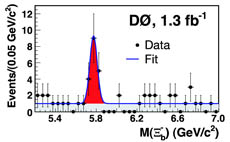
The invariant mass of the reconstructed Ξb± candidate events observed by DZero researchers.
DZero researchers have just announced the newest arrival to the Standard Model's particle zoo: the Ξb± baryon (aka, the charged cascade-b). The particle zoo is a busy place, showcasing lots of particles and their odd-sounding names. Visitors can see muons in the lepton area or charm quarks in the quark exhibit. The meson galleries hold pions and kaons, while the baryon enclosure holds the most exotic specimens of all.
Baryons are members of the hadron family, made of quarks bound by the strong nuclear force. Baryons consist of three quarks, and DZero's discovery is a strangely beautiful example: it is made of a down, strange, and bottom quark. This makes the Ξb± the first observed particle containing members of all three generations of matter.
The Standard Model groups its twelve most fundamental particles (the quarks and leptons) into three distinct generations of matter, each containing heavier particles than the last. The lightest generation includes the up and down quarks. Heavier charm and strange quarks form the second generation, while the top and bottom, the heaviest quarks, represent the third. Our universe is made almost exclusively of members of the first generation. The heavier particles were common in the early universe, but became rare as the universe expanded and cooled, losing the energy required to create particles with such large masses.
The Standard Model predicts that the Ξb± exists. Theoretical calculations suggest its mass should be just larger than six times the proton mass. But until now, the Ξb± was elusive, with only indirect evidence for its existence. The Tevatron is the perfect habitat in which to hunt for such exotic quarry, along with a host of eager physicists ready to take on the task. Finding evidence for the Ξb± proved to be extremely challenging, however, as it must be detected through a complicated decay process. After they are produced, heavy particles tend to decay very quickly into lighter particles. Through a chain of four decays, the Ξb± generates a complicated final state: two muons (heavy cousins of electrons), two pions (mesons consisting of two light quarks), and an ordinary proton. This gives the DZero scientists five final state particles and three decay vertices to make sure they found the right beast. The decay vertices help in deciding which particles belong together, and by recursively reconstructing each step in the decay chain, the DZero researchers can determine the properties of the Ξb± particle at the beginning of the chain.
DZero collaborators methodically hunted through trillions of Tevatron proton-antiproton collisions to find candidates for Ξb± decays. In 1.3 inverse femtobarns of data, they observed 19 such candidates, of which 4 are expected to be background events. This observation represents a 5.5-sigma excess above expected backgrounds. They determined the mass of the Ξb± to be 5.77±0.02 GeV/c2, which agrees well with the Standard Model prediction. This discovery is not only a great success for DZero researchers and the Tevatron community, but also lays the groundwork for those who endeavor to bring more exotic particles into the diverse Standard Model zoo.
The details of the Ξb± discovery will be presented at a special seminar at 1:00 PM in 1 West this Friday. More information is available here, and the paper submitted to Physical Review Letters can be found here.
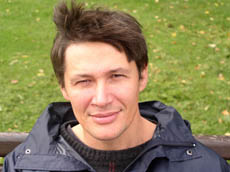
For this analysis, a preselected event sample was re-processed with a special version of the DZero tracking; this significantly increased the efficiency to reconstruct particles that are produced far from the primary proton-antiproton collision point. The author of this tracking code ("extended-AA") is Guennadi Borrisov (Lancaster University, UK), pictured above.
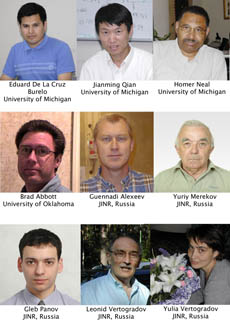
A team of DZero researchers from Russia and the United States designed the search for the Ξb± baryon. Not pictured: Alexandr Rozhdestvenskiy.
|
|
Mentoring Sessions at DASTOW
High school-age girls can sign up for one-on-one sessions with scientists and engineers. The sessions will be held during DASTOW, June 21. Pre-registration is necessary. Information about the mentors and the program is available here.
Today is an Air Pollution Action Day
The Partners for Clean Air and the Illinois Environmental Protection
Agency are issuing a second Air Pollution Action Day notice for
Thursday, June 14. Check www.cleantheair.org for updates and tips on reducing impact.
Sign up for Fermilab Blood Drive
Employees, users and summers students can now sign up for Fermilab's quartlerly blood drive, taking place Tuesday, June 26 and Wednesday June 27 from 8:00 a.m. to 2:00 p.m. Walk ins will be welcome. The blood drive will be located in the Wilson Hall ground floor training room. Call Diana at x3771 or Margie at x3411 or sign up online.
Salary review information for supervisors
Managers and supervisors will receive information on new features of this year's performance and salary review process in one-hour
training sessions scheduled on June 14, 15 and 25. Enroll here.
June Wilson Hall window washing
Window washing began yesterday at Wilson Hall and will continue through the end of June. The exterior of Wilson Hall will be washed this week. Please avoid walking through or moving barricades.
Men's locker room closed this week
The men's locker room on the ground floor of Wilson Hall will be closed through June 15 for ceramic tile repair.
International Folk Dancing Thursday
International Folk Dancing will meet Thursday at 7:30 p.m. in Ramsey Auditorium. This will be the time and location for all summer meetings. Newcomers are always welcome, and you don't need to come with a partner. For more information call 630-584-0825 or 630-840-8194 or email.
|
|